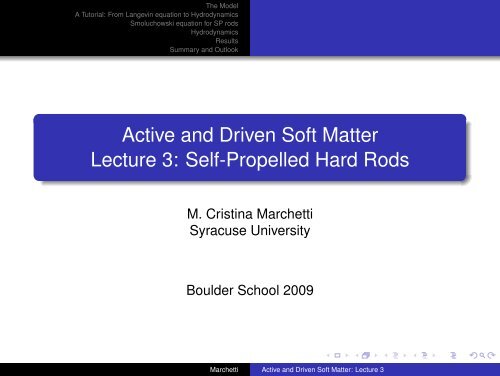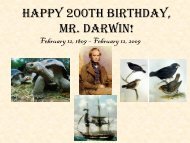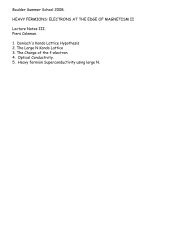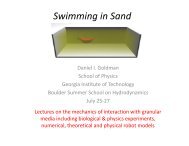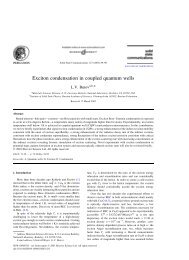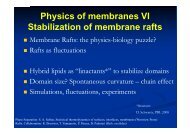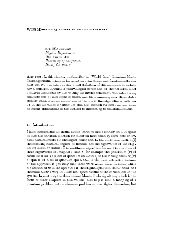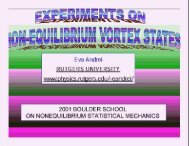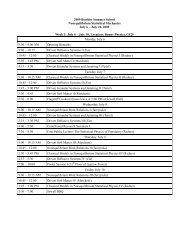Active and Driven Soft Matter Lecture 3 - Boulder School for ...
Active and Driven Soft Matter Lecture 3 - Boulder School for ...
Active and Driven Soft Matter Lecture 3 - Boulder School for ...
Create successful ePaper yourself
Turn your PDF publications into a flip-book with our unique Google optimized e-Paper software.
The Model<br />
A Tutorial: From Langevin equation to Hydrodynamics<br />
Smoluchowski equation <strong>for</strong> SP rods<br />
Hydrodynamics<br />
Results<br />
Summary <strong>and</strong> Outlook<br />
<strong>Active</strong> <strong>and</strong> <strong>Driven</strong> <strong>Soft</strong> <strong>Matter</strong><br />
<strong>Lecture</strong> 3: Self-Propelled Hard Rods<br />
M. Cristina Marchetti<br />
Syracuse University<br />
<strong>Boulder</strong> <strong>School</strong> 2009<br />
Marchetti <strong>Active</strong> <strong>and</strong> <strong>Driven</strong> <strong>Soft</strong> <strong>Matter</strong>: <strong>Lecture</strong> 3
The Model<br />
A Tutorial: From Langevin equation to Hydrodynamics<br />
Smoluchowski equation <strong>for</strong> SP rods<br />
Hydrodynamics<br />
Results<br />
Summary <strong>and</strong> Outlook<br />
<strong>Lecture</strong> 1: Table of Contents<br />
1 The Model<br />
<strong>Active</strong> Hard Rod Nematic<br />
Plan <strong>and</strong> Results<br />
2 A Tutorial: From Langevin equation to Hydrodynamics<br />
Langevin dynamics<br />
From Langevin to Fokker-Planck dynamics<br />
Low density limit & Smoluchowski equation<br />
Hydrodynamics<br />
Summary <strong>and</strong> Plan<br />
3 Smoluchowski equation <strong>for</strong> SP rods<br />
Langevin dynamics of SP Rods<br />
Smoluchowski equation <strong>for</strong> SP rods<br />
4 Hydrodynamics<br />
Hydrodynamics Fields<br />
Hydrodynamics Equations<br />
5 Results<br />
Homogeneous States <strong>and</strong> Enhanced Nematic Order<br />
Stability <strong>and</strong> Novel Properties of Bulk States<br />
6 Summary <strong>and</strong> Outlook<br />
Marchetti <strong>Active</strong> <strong>and</strong> <strong>Driven</strong> <strong>Soft</strong> <strong>Matter</strong>: <strong>Lecture</strong> 3
The Model<br />
A Tutorial: From Langevin equation to Hydrodynamics<br />
Smoluchowski equation <strong>for</strong> SP rods<br />
Hydrodynamics<br />
Results<br />
Summary <strong>and</strong> Outlook<br />
<strong>Active</strong> Hard Rod Nematic<br />
<strong>Active</strong> Hard Rod Nematic<br />
Plan <strong>and</strong> Results<br />
•2d hard rods<br />
•Excluded volume interaction<br />
•Overdamped dynamics<br />
•Non-thermal white noise<br />
hard rod nematic<br />
+ self-propulsion v 0<br />
along long axis<br />
v 0<br />
1. Start with Langevin dynamics of coupled orientational <strong>and</strong><br />
translational degrees of freedom plus hard core collisions<br />
SP yields anisotropic enhancement of<br />
ˆk <br />
momentum transferred in a hard core<br />
1<br />
collision<br />
v 1<br />
v2<br />
2. Derive continuum theory<br />
2<br />
Marchetti <strong>Active</strong> <strong>and</strong> <strong>Driven</strong> <strong>Soft</strong> <strong>Matter</strong>: <strong>Lecture</strong> 3
The Model<br />
A Tutorial: From Langevin equation to Hydrodynamics<br />
Smoluchowski equation <strong>for</strong> SP rods<br />
Hydrodynamics<br />
Results<br />
Summary <strong>and</strong> Outlook<br />
Plan <strong>and</strong> Results<br />
<strong>Active</strong> Hard Rod Nematic<br />
Plan <strong>and</strong> Results<br />
The lecture illustrates how to use the tools of statistical physics to derive<br />
hydrodynamics from microscopic dynamics <strong>for</strong> a minimal model of a<br />
self-propelled system.<br />
Inspired by Vicsek model of SP point particles that align with neighbors<br />
according to prescribed rules in the presence of noise. This rule-based<br />
model orders in polar (moving) states below a critical value of the noise.<br />
Hard rods order in nematic states due to steric effects: can excluded<br />
volume interactions, plus self-propulsion, yield a polar state<br />
Result: no homogeneous polar state, but other nonequilibrium effects:<br />
SP enhances nematic order<br />
SP enhances longitudinal diffusion ("persistent" r<strong>and</strong>om walk)<br />
SP yields propagating sound-like waves in the isotropic state<br />
SP destabilizes the nematic state<br />
SP+boundary effects can yield a polar state<br />
Marchetti <strong>Active</strong> <strong>and</strong> <strong>Driven</strong> <strong>Soft</strong> <strong>Matter</strong>: <strong>Lecture</strong> 3
The Model<br />
A Tutorial: From Langevin equation to Hydrodynamics<br />
Smoluchowski equation <strong>for</strong> SP rods<br />
Hydrodynamics<br />
Results<br />
Summary <strong>and</strong> Outlook<br />
Langevin dynamics<br />
Langevin dynamics<br />
From Langevin to Fokker-Planck dynamics<br />
Low density limit & Smoluchowski equation<br />
Hydrodynamics<br />
Summary <strong>and</strong> Plan<br />
Spherical particle of radius a <strong>and</strong> mass m, in one dimension<br />
m dv<br />
dt<br />
= −ζv + η(t) ζ = 6πηa friction<br />
noise is uncorrelated in 〈η(t)〉 = 0<br />
time <strong>and</strong> Gaussian: 〈η(t)η(t ′ )〉 = 2∆δ(t − t ′ )<br />
Noise strength ∆<br />
In equilibrium ∆ is determined by requiring<br />
lim t→∞ < [v(t)] 2 >=< v 2 > eq = k BT<br />
m<br />
⇒ ∆ = ζk BT<br />
m 2<br />
Mean square displacement is diffusive<br />
< [∆x(t)] 2 >= 2k [<br />
BT<br />
t − m (<br />
1 − e −ζt/m)] → 2k BT<br />
t = 2Dt<br />
ζ ζ<br />
ζ<br />
Marchetti <strong>Active</strong> <strong>and</strong> <strong>Driven</strong> <strong>Soft</strong> <strong>Matter</strong>: <strong>Lecture</strong> 3
The Model<br />
A Tutorial: From Langevin equation to Hydrodynamics<br />
Smoluchowski equation <strong>for</strong> SP rods<br />
Hydrodynamics<br />
Results<br />
Summary <strong>and</strong> Outlook<br />
Fokker-Plank equation<br />
Langevin dynamics<br />
From Langevin to Fokker-Planck dynamics<br />
Low density limit & Smoluchowski equation<br />
Hydrodynamics<br />
Summary <strong>and</strong> Plan<br />
Many-particle systems<br />
In this case it is convenient to work with phase-space distribution<br />
functions:<br />
ˆfN (x 1 , p 1 , x 2 , p 2 , ..., x N , p N , t) ≡ ˆf N (x N , p N , t)<br />
These are useful when dealing with both Hamiltonian dynamics <strong>and</strong><br />
Langevin (stochastic) dynamics.<br />
First step:<br />
Trans<strong>for</strong>m the Langevin equation into a Fokker-Plank equation <strong>for</strong> the<br />
noise-average distribution function<br />
f 1 (x, p, t) =< ˆf 1 (x, p, t) ><br />
Marchetti <strong>Active</strong> <strong>and</strong> <strong>Driven</strong> <strong>Soft</strong> <strong>Matter</strong>: <strong>Lecture</strong> 3
The Model<br />
A Tutorial: From Langevin equation to Hydrodynamics<br />
Smoluchowski equation <strong>for</strong> SP rods<br />
Hydrodynamics<br />
Results<br />
Summary <strong>and</strong> Outlook<br />
Fokker-Plank equation - 2<br />
Langevin dynamics<br />
From Langevin to Fokker-Planck dynamics<br />
Low density limit & Smoluchowski equation<br />
Hydrodynamics<br />
Summary <strong>and</strong> Plan<br />
Compact notation<br />
dv<br />
dt<br />
dx<br />
= p/m<br />
dt<br />
= −ζv − dU<br />
dx + η(t)<br />
⇒ dX<br />
dt<br />
= V + η(t)<br />
„ « x<br />
X =<br />
p<br />
„<br />
«<br />
p/m<br />
V =<br />
−ζv − U<br />
„ «<br />
′ 0<br />
η =<br />
η<br />
Conservation law <strong>for</strong> probability distribution<br />
∫ (<br />
dX ˆf (X, t) = 1 ⇒ ∂tˆf +<br />
∂<br />
∂X · ∂X ˆf<br />
)<br />
∂t<br />
= 0<br />
( ) ( )<br />
( )<br />
∂ tˆf +<br />
∂<br />
∂X · Vˆf + ∂<br />
∂X · ηˆf = 0 ⇒ ∂ tˆf + Lˆf +<br />
∂<br />
∂X · ηˆf = 0<br />
∫ t<br />
ˆf (X, t) = e −Lt f (X, 0) − ds e −L(t−s) ∂<br />
0<br />
∂X η(s)ˆf (x, s)<br />
Marchetti <strong>Active</strong> <strong>and</strong> <strong>Driven</strong> <strong>Soft</strong> <strong>Matter</strong>: <strong>Lecture</strong> 3
The Model<br />
A Tutorial: From Langevin equation to Hydrodynamics<br />
Smoluchowski equation <strong>for</strong> SP rods<br />
Hydrodynamics<br />
Results<br />
Summary <strong>and</strong> Outlook<br />
Fokker-Plank equation - 3<br />
Langevin dynamics<br />
From Langevin to Fokker-Planck dynamics<br />
Low density limit & Smoluchowski equation<br />
Hydrodynamics<br />
Summary <strong>and</strong> Plan<br />
Use properties of Gaussian noise to carry out averages<br />
∂ t < ˆf > +<br />
∂<br />
∂X · V < ˆf > + ∂<br />
∂X · < η(t)e−Lt f (X, 0) ><br />
− ∂ Z t<br />
∂X · < η(t) ds e −L(t−s) ∂<br />
0<br />
∂X η(s)ˆf (X, s) > = 0<br />
∂ t f = − p m ∂ xf − ∂ p [−U ′ (x) − ζp/m]f + ∆∂ 2 pf<br />
Fokker-Plank eq. easily generalized to many interacting particles<br />
dp α<br />
= −ζv α − X ∂ xα V (x α − x β ) + η α(t)<br />
dt<br />
β<br />
Z<br />
∂ t f 1 (1, t) = −v 1 ∂ x1 f 1 (1) + ζ∂ p1 v 1 f 1 (1) + ∆∂p 2 1<br />
f 1 (1) + ∂ p1 d2 ∂ x1 V (x 12 )f 2 (1, 2, t)<br />
Marchetti <strong>Active</strong> <strong>and</strong> <strong>Driven</strong> <strong>Soft</strong> <strong>Matter</strong>: <strong>Lecture</strong> 3
The Model<br />
A Tutorial: From Langevin equation to Hydrodynamics<br />
Smoluchowski equation <strong>for</strong> SP rods<br />
Hydrodynamics<br />
Results<br />
Summary <strong>and</strong> Outlook<br />
Smoluchowski equation<br />
Langevin dynamics<br />
From Langevin to Fokker-Planck dynamics<br />
Low density limit & Smoluchowski equation<br />
Hydrodynamics<br />
Summary <strong>and</strong> Plan<br />
1<br />
One obtains a hierarchy of Fokker-Planck equations <strong>for</strong> f 1 (1),<br />
f 2 (1, 2), f 3 (1, 2, 3), ... To proceed we need a closure ansatz. Low<br />
density (neglect correlations) f 2 (1, 2, t) ≃ f 1 (1, t)f 1 (2, t)<br />
2<br />
It is instructive to solve the FP equation by taking moments<br />
c(x, t) = R dp f (x, p, t)<br />
J(x, t) = R dp (p/m)f (x, p, t)<br />
concentration of particles<br />
density current<br />
Eqs. <strong>for</strong> the moments obtained by integrating the FP equation.<br />
∂ t c(x, t) = −∂ x J(x, t)<br />
∂ t J(x 1 ) = −ζJ(x 1 ) − m∆<br />
ζ ∂x 1 c(x 1) − R dx 2 [∂ x1 V (x 12 )]c(x 1 , t)c(x 2 , t)<br />
For t >> ζ −1 , we eliminate J to obtain a Smoluchowski eq. <strong>for</strong> c<br />
∂ t c(x 1 , t) = D∂ 2 x 1<br />
c(x 1 , t) + 1 ζ ∂ x 1<br />
∫x 2<br />
[∂ x1 V (x 12 )]c(x 1 , t)c(x 2 , t)<br />
Marchetti <strong>Active</strong> <strong>and</strong> <strong>Driven</strong> <strong>Soft</strong> <strong>Matter</strong>: <strong>Lecture</strong> 3
The Model<br />
A Tutorial: From Langevin equation to Hydrodynamics<br />
Smoluchowski equation <strong>for</strong> SP rods<br />
Hydrodynamics<br />
Results<br />
Summary <strong>and</strong> Outlook<br />
Hydrodynamics<br />
Langevin dynamics<br />
From Langevin to Fokker-Planck dynamics<br />
Low density limit & Smoluchowski equation<br />
Hydrodynamics<br />
Summary <strong>and</strong> Plan<br />
Due to the interaction with the substrate, momentum is not<br />
conserved. The only conserved field is the concentration of particles<br />
c(x, t). This is the only hydrodynamic field.<br />
To obtain a hydrodynamic equation <strong>for</strong>m the Smoluchowski equation we recall that we<br />
are interested in large scales. Assuming the pair potential has a finite range R 0 , we<br />
consider spatial variation of c(x, t) on length scales x >> R 0 <strong>and</strong> exp<strong>and</strong> in gradients<br />
∂ t c(x 1 , t) = D∂x 2 1<br />
c(x 1 , t) + 1 Z<br />
ζ ∂x 1<br />
V (x ′ )[∂ x ′c(x 1 + x ′ , t)]c(x 1 , t)<br />
x ′<br />
= D∂x 2 1<br />
c(x 1 , t) + 1 Z<br />
ζ ∂x 1<br />
V (x ′ )[∂ x1 c(x 1 , t) + x ′ ∂ 2<br />
x ′ x 1<br />
c(x 1 , t) + ...]c(x 1 , t)<br />
The result is the expected diffusion equation, with a microscopic<br />
expression <strong>for</strong> D ren which is renormalized by interactions<br />
∂ t c(x, t) = ∂ x [D ren ∂ x c(x, t)] ≃ D ren ∂ 2 x c(x, t)<br />
Marchetti <strong>Active</strong> <strong>and</strong> <strong>Driven</strong> <strong>Soft</strong> <strong>Matter</strong>: <strong>Lecture</strong> 3
The Model<br />
A Tutorial: From Langevin equation to Hydrodynamics<br />
Smoluchowski equation <strong>for</strong> SP rods<br />
Hydrodynamics<br />
Results<br />
Summary <strong>and</strong> Outlook<br />
Summary of Tutorial <strong>and</strong> Plan<br />
Langevin dynamics<br />
From Langevin to Fokker-Planck dynamics<br />
Low density limit & Smoluchowski equation<br />
Hydrodynamics<br />
Summary <strong>and</strong> Plan<br />
Microscopic Langevin dynamics of interacting particles<br />
Approximations: noise average; low density: f 2 (1, 2) ≃ f 1 (1)f 1 (2)<br />
⇓<br />
Fokker Planck equation<br />
⇓<br />
Overdamped limit: t >> 1/ζ Smoluchowski equation<br />
[<br />
∂ t c(x 1 , t) = ∂ x1 D∂ x1 c(x 1 , t) − 1 ∫<br />
]<br />
F (x 12 )c(x 2 , t)c(x 1 , t<br />
ζ x 2<br />
Pair interaction F (x 12 ):<br />
steric repulsion → SP rods<br />
short-range active interactions → cross-linkers in motor-filaments mixtures<br />
medium-mediated hydrodynamic interactions → swimmers<br />
Smoluchowski → Hydrodynamic equations<br />
Marchetti <strong>Active</strong> <strong>and</strong> <strong>Driven</strong> <strong>Soft</strong> <strong>Matter</strong>: <strong>Lecture</strong> 3
SP Rods<br />
The Model<br />
A Tutorial: From Langevin equation to Hydrodynamics<br />
Smoluchowski equation <strong>for</strong> SP rods<br />
Hydrodynamics<br />
Results<br />
Summary <strong>and</strong> Outlook<br />
Langevin dynamics of SP Rods<br />
Smoluchowski equation <strong>for</strong> SP rods<br />
The algebra is quite a bit more involved <strong>for</strong> a number of reasons:<br />
1<br />
translational <strong>and</strong> rotational degrees of freedom are coupled<br />
∂v α<br />
∂t<br />
= v 0 ˆν α − ζ(ˆν α) · v α − P β T (α, β) vα + ηα (t)<br />
∂ω α<br />
∂t<br />
= −ζ R ω α − P β T (α, β) ωα + ηR α (t)<br />
where ˙η αi (t)η βj (t ′ )¸ = 2k B T a ζ ij (ˆν α)δ ij δ (t − t ′ )<br />
D<br />
E<br />
ηα R (t) ηβ R (t′ ) = 2k B T a (ζ R /I) δ αβ δ (t − t ′ ), I = l 2 /12<br />
ζ ij (ˆν α) = ζ ‖ˆν αi ˆν αj + ζ ⊥ (δ ij − ˆν αi ˆν αj )<br />
2<br />
hard core interactions must be treated with care to h<strong>and</strong>le<br />
properly the instantaneous momentum transfer<br />
3<br />
coupling of self-propulsion <strong>and</strong> collisional dynamics yields<br />
angular correlations<br />
Marchetti <strong>Active</strong> <strong>and</strong> <strong>Driven</strong> <strong>Soft</strong> <strong>Matter</strong>: <strong>Lecture</strong> 3
The Model<br />
A Tutorial: From Langevin equation to Hydrodynamics<br />
Smoluchowski equation <strong>for</strong> SP rods<br />
Hydrodynamics<br />
Results<br />
Summary <strong>and</strong> Outlook<br />
Langevin dynamics of SP Rods<br />
Smoluchowski equation <strong>for</strong> SP rods<br />
Smoluchowski equation <strong>for</strong> SP rods<br />
The Smoluchowski equation <strong>for</strong> c(r, ˆν, t) is given by<br />
∂ t c + v 0 ∂ ‖ c = D R ∂ 2 θc + (D ‖ + D S )∂ 2 ‖ c + D ⊥∂ 2 ⊥c<br />
−(Iζ R ) −1 ∂ θ (τ ex + τ SP ) − ∇ · ζ −1 · (F ex + F SP )<br />
∂ ‖ = ˆν · ∇<br />
D S = v0 2/ζ ‖ enhancement of<br />
∂ ⊥ = ∇ − ˆν(ˆν · ∇)<br />
longitudinal diffusion<br />
Torques <strong>and</strong> <strong>for</strong>ces exchanged upon collision as the sum of Onsager<br />
excluded volume terms <strong>and</strong> contributions from self-propulsion:<br />
τ ex = −∂ θ V ex<br />
V<br />
F ex = −∇V<br />
ex (1) = k B T ac(1, t) R R<br />
ξ ex<br />
12 ˆν |ˆν<br />
2<br />
1 × ˆν 2 | c (r 1 + ξ 12 , ˆν 2 , t)<br />
ξ 12 = ξ 1 − ξ 2<br />
„ « Z !<br />
′<br />
FSP<br />
= v<br />
τ 0<br />
2 b k<br />
SP ẑ · (ξ 1 × b [ẑ · (ˆν 1 × ˆν 2 )] 2<br />
k)<br />
s 1 ,s 2<br />
Z2,ˆk<br />
×Θ(−ˆν 12 · bk)c(1, t)c(2, t)<br />
Marchetti <strong>Active</strong> <strong>and</strong> <strong>Driven</strong> <strong>Soft</strong> <strong>Matter</strong>: <strong>Lecture</strong> 3
The Model<br />
A Tutorial: From Langevin equation to Hydrodynamics<br />
Smoluchowski equation <strong>for</strong> SP rods<br />
Hydrodynamics<br />
Results<br />
Summary <strong>and</strong> Outlook<br />
SP terms in Smoluchowski Eq.<br />
Langevin dynamics of SP Rods<br />
Smoluchowski equation <strong>for</strong> SP rods<br />
Convective term describes mass flux along the rod’s long axis.<br />
Longitudinal diffusion enhanced by self-propulsion:<br />
D ‖ → D ‖ + v 2 0 /ζ ‖. Longitudinal diffusion of SP rod as persistent<br />
r<strong>and</strong>om walk with bias ∼ v 0 towards steps along the rod’s long<br />
axis.<br />
The SP contributions to <strong>for</strong>ce <strong>and</strong> torque describe, within<br />
mean-field, the additional anisotropic linear <strong>and</strong> angular<br />
momentum transfers during the collision of two SP rods.<br />
D E<br />
√<br />
∆pcoll<br />
Mean-field Onsager: ∼ v th<br />
∼<br />
∆t τ √ kB T a<br />
∼ k BT a<br />
coll l/ k B T a<br />
l<br />
D E<br />
∆pcoll<br />
SP rods: ∆t ∼ v 0| ˆν 1 × ˆν 2 |<br />
SP<br />
l/v 0 | ˆν 1 × ˆν 2 | ∼ v 0 2|ˆν 1 × ˆν 2 | 2<br />
Marchetti <strong>Active</strong> <strong>and</strong> <strong>Driven</strong> <strong>Soft</strong> <strong>Matter</strong>: <strong>Lecture</strong> 3
The Model<br />
A Tutorial: From Langevin equation to Hydrodynamics<br />
Smoluchowski equation <strong>for</strong> SP rods<br />
Hydrodynamics<br />
Results<br />
Summary <strong>and</strong> Outlook<br />
Hydrodynamics Fields<br />
Hydrodynamics Fields<br />
Hydrodynamics Equations<br />
Conserved density: ρ(r, t) = ∫ c(r, ˆν, t)<br />
ˆν<br />
Order parameter fields:<br />
Polarization vector:<br />
P(r, t) = ∫ ˆν c(r, ˆν, t)<br />
ˆν<br />
Polar order<br />
p -p <br />
fish, bacteria,<br />
motor-filaments<br />
p<br />
Nematic alignment tensor:<br />
Q ij (r, t) = ∫ ˆν (ˆν i ˆν j − 1 2 δ ij)c(r, ˆν, t)<br />
Nematic<br />
order<br />
n -n<br />
<br />
melanocytes,<br />
granular rods<br />
n<br />
Marchetti <strong>Active</strong> <strong>and</strong> <strong>Driven</strong> <strong>Soft</strong> <strong>Matter</strong>: <strong>Lecture</strong> 3
The Model<br />
A Tutorial: From Langevin equation to Hydrodynamics<br />
Smoluchowski equation <strong>for</strong> SP rods<br />
Hydrodynamics<br />
Results<br />
Summary <strong>and</strong> Outlook<br />
Hydrodynamics Equations<br />
Hydrodynamics Fields<br />
Hydrodynamics Equations<br />
∂ t ρ + v 0 ∇ · P = D ρ∇ 2 ρ + D Q ∇∇ : ρQ<br />
∂ t P = −D R P + λP · Q − v 0 ∇ · Q − λ 1 (P · ∇)P − λ 2 ∇P 2 − λ 3 P(∇ · P)<br />
− v 0<br />
2 ∇ρ + D bend ∇ 2 P + (D splay − D benb )∇(∇ · P)<br />
∂ t Q = −4D R<br />
„<br />
1 − ρ<br />
ρ IN<br />
«<br />
Q − v 0 [∇P] ST − λ 4 [P∇Q] ST − λ 5 [Q∇P] ST − λ 6 [∇P] ST<br />
[T] ST<br />
ij = 1 2 (T ij + T ji − 1 2 δ ij T kk )<br />
+ D Q<br />
4 (∇∇ − 1 2 1)ρ + D′ Q ∇2 Q<br />
Marchetti <strong>Active</strong> <strong>and</strong> <strong>Driven</strong> <strong>Soft</strong> <strong>Matter</strong>: <strong>Lecture</strong> 3
The Model<br />
A Tutorial: From Langevin equation to Hydrodynamics<br />
Smoluchowski equation <strong>for</strong> SP rods<br />
Hydrodynamics<br />
Results<br />
Summary <strong>and</strong> Outlook<br />
Homogeneous States<br />
Homogeneous States <strong>and</strong> Enhanced Nematic Order<br />
Stability <strong>and</strong> Novel Properties of Bulk States<br />
Neglecting all gradients, the equations are given by<br />
Bulk states:<br />
∂ t ρ = 0<br />
∂ t P = −D R P + λP · Q<br />
Isotropic State: ρ = ρ 0 , P = Q = 0<br />
No bulk uni<strong>for</strong>m polar state: P = 0<br />
Nematic state P = 0, Q ≠ 0 <strong>for</strong><br />
ρ > ρ IN<br />
SP enhances nematic order:<br />
ρ IN =<br />
ρ N<br />
1+ v2 0<br />
5k B T<br />
∂ t Q = −4D R [1 − ρ/ρ IN (v 0 )] Q<br />
with ρ N = 3/(πl 2 )<br />
Marchetti <strong>Active</strong> <strong>and</strong> <strong>Driven</strong> <strong>Soft</strong> <strong>Matter</strong>: <strong>Lecture</strong> 3
The Model<br />
A Tutorial: From Langevin equation to Hydrodynamics<br />
Smoluchowski equation <strong>for</strong> SP rods<br />
Hydrodynamics<br />
Results<br />
Summary <strong>and</strong> Outlook<br />
Homogeneous States <strong>and</strong> Enhanced Nematic Order<br />
Stability <strong>and</strong> Novel Properties of Bulk States<br />
Enhanced Nematic order in Simulations of Actin<br />
Motility Assay<br />
-<br />
+<br />
Marchetti <strong>Active</strong> <strong>and</strong> <strong>Driven</strong> <strong>Soft</strong> <strong>Matter</strong>: <strong>Lecture</strong> 3
The Model<br />
A Tutorial: From Langevin equation to Hydrodynamics<br />
Smoluchowski equation <strong>for</strong> SP rods<br />
Hydrodynamics<br />
Results<br />
Summary <strong>and</strong> Outlook<br />
Homogeneous States <strong>and</strong> Enhanced Nematic Order<br />
Stability <strong>and</strong> Novel Properties of Bulk States<br />
Hydrodynamic Modes Stability of Bulk States<br />
We examine the dynamics of the fluctuations of the hydrodynamic<br />
fields about their mean values <strong>and</strong> analyze the hydrodynamic modes<br />
of the system.<br />
ρ = ρ<br />
Isotropic state (neglect Q)<br />
0 + δρ<br />
P = 0 + δP<br />
Linearized equations:<br />
Fourier modes:<br />
∂ t δρ = D ρ ∇ 2 δρ + v 0 ρ 0 ∇ · δP<br />
∂ t δP = −D R δP + (v 0 /2ρ 0 )∇δρ<br />
δρ(r, t) = ∑ k δρ k(t)e ik·r<br />
δP(r, t) = ∑ k δP k(t)e ik·r<br />
z ± = − 1 2 (D R + D ρ k 2 ) ± 1 2<br />
√<br />
(D R − D ρ k 2 ) 2 − 2v 2 0 k 2<br />
δρ k (t) ∼ e −z(k)t<br />
δP k (t) ∼ e −z(k)t<br />
Marchetti <strong>Active</strong> <strong>and</strong> <strong>Driven</strong> <strong>Soft</strong> <strong>Matter</strong>: <strong>Lecture</strong> 3
The Model<br />
A Tutorial: From Langevin equation to Hydrodynamics<br />
Smoluchowski equation <strong>for</strong> SP rods<br />
Hydrodynamics<br />
Results<br />
Summary <strong>and</strong> Outlook<br />
Sound Waves in Isotropic State<br />
Homogeneous States <strong>and</strong> Enhanced Nematic Order<br />
Stability <strong>and</strong> Novel Properties of Bulk States<br />
Propagating density waves in isotropic<br />
state of overdamped SP rods<br />
<br />
t<br />
= D <br />
2 + v 0<br />
0P<br />
<br />
tP = DRP + v0 0<br />
fluctuations:<br />
<br />
= 0<br />
+ , P = P 0<br />
0<br />
+ P<br />
<br />
v 0<br />
Above a critical v 0 the<br />
system supports sound-like<br />
waves in a range of<br />
wavevectors<br />
v 0c<br />
v 0c<br />
D R<br />
Ramaswamy & Mazenko, 1982: fluid on frictional substrate<br />
--> movie of fluidized rods by Durian’s lab<br />
Marchetti <strong>Active</strong> <strong>and</strong> <strong>Driven</strong> <strong>Soft</strong> <strong>Matter</strong>: <strong>Lecture</strong> 3
The Model<br />
A Tutorial: From Langevin equation to Hydrodynamics<br />
Smoluchowski equation <strong>for</strong> SP rods<br />
Hydrodynamics<br />
Results<br />
Summary <strong>and</strong> Outlook<br />
Instability of Nematic State<br />
Homogeneous States <strong>and</strong> Enhanced Nematic Order<br />
Stability <strong>and</strong> Novel Properties of Bulk States<br />
The nematic state is unstable<br />
<strong>for</strong> v 0 > v c (φ, S), as shown in<br />
the figure <strong>for</strong> S = 1 (red line)<br />
<strong>and</strong> S < 1 (dashed blue line).<br />
The instability arises from a<br />
subtle interplay of splay <strong>and</strong><br />
bend de<strong>for</strong>mations.<br />
cosφ = ˆn 0 · ˆk<br />
φ = 0 pure bend<br />
φ = π/2 pure splay<br />
Marchetti <strong>Active</strong> <strong>and</strong> <strong>Driven</strong> <strong>Soft</strong> <strong>Matter</strong>: <strong>Lecture</strong> 3
The Model<br />
A Tutorial: From Langevin equation to Hydrodynamics<br />
Smoluchowski equation <strong>for</strong> SP rods<br />
Hydrodynamics<br />
Results<br />
Summary <strong>and</strong> Outlook<br />
Homogeneous States <strong>and</strong> Enhanced Nematic Order<br />
Stability <strong>and</strong> Novel Properties of Bulk States<br />
Enhanced polar order near boundaries<br />
SP can enhance the size of correlated polar regions, as seen in<br />
simulations [F. Peruani, A. Deutsch <strong>and</strong> M. Bär, Phys. Rev. E 74,<br />
030904 (2006).].<br />
Polarization profile across<br />
channel (P x (±L/2) = P 0 )<br />
P x (y) = P 0 cosh(y/δ)/ cosh(L/2δ)<br />
√<br />
δ = l/2 5/2 + v0 2/k BT<br />
δ(v 0 = 0) ∼ l<br />
Marchetti <strong>Active</strong> <strong>and</strong> <strong>Driven</strong> <strong>Soft</strong> <strong>Matter</strong>: <strong>Lecture</strong> 3
The Model<br />
A Tutorial: From Langevin equation to Hydrodynamics<br />
Smoluchowski equation <strong>for</strong> SP rods<br />
Hydrodynamics<br />
Results<br />
Summary <strong>and</strong> Outlook<br />
Summary <strong>and</strong> Outlook<br />
A minimal model of interacting SP hard rods exhibits several<br />
novel nonequilibrium phenomena at large scales<br />
No bulk polar state<br />
enhancement of nematic order<br />
enhancement of longitudinal diffusion<br />
sound waves in isotropic state<br />
enhanced polarization correlations<br />
We will consider in the last lecture a richer model that<br />
incorporates the role of fluid flow.<br />
References<br />
1 R. Zwanzig, Nonequilibrium Statistical Mechanics (Ox<strong>for</strong>d University Press,<br />
2001), Chapters 1 <strong>and</strong> 2.<br />
2 A. Baskaran <strong>and</strong> M. C. Marchetti, Hydrodynamics of Self-Propelled Hard<br />
Rods, Phys. Rev. E 77, 011920 (2008).<br />
3 A. Baskaran <strong>and</strong> M. C. Marchetti, Enhanced Diffusion <strong>and</strong> Ordering of<br />
Self-Propelled Rods, Phys. Rev. Lett. 101, 268101 (2008).<br />
Marchetti <strong>Active</strong> <strong>and</strong> <strong>Driven</strong> <strong>Soft</strong> <strong>Matter</strong>: <strong>Lecture</strong> 3


